About us
JAXA Aviation helps to create a safer and more prosperous society with aeronautics-related research and development activities.
FLIGHT PATH No.24 | 2019 WINTER
Challenges of Young Researchers Round table discussions in pursuit of the challenges set in the Fourth Mid-to-long-term Plan
Supersonic aircraft
Aspirations for "fast" aircraft
-
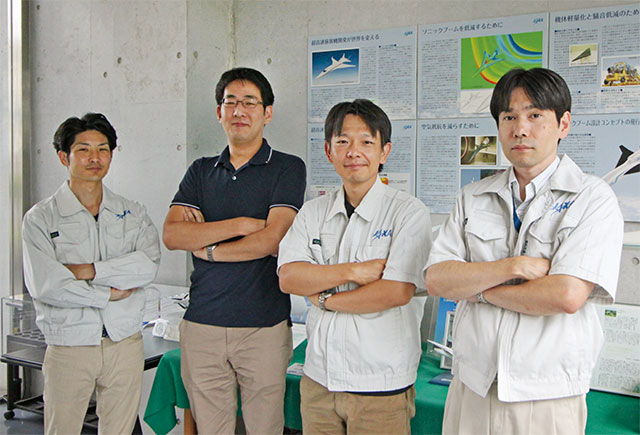
- Naka: You’ve all been doing research in the area of supersonic aircraft since when you were in university. Why did you choose this particular field? Where does your passion for supersonic aircraft come from?
Akatsuka: I’d actually never boarded an airplane until after I started studying airplanes. My first flight was to France, and it took more than 10 hours. It was such a painful experience. I felt that as a means of transportation, there was still a lot of room for development in airplanes. I believe more people would use airplanes if there were faster, more comfortable aircraft.
Ueno: I’ve always been attracted to anything that was fast, so I was naturally drawn to supersonic and hypersonic aircraft. The fact that I used to live near an airport as a child also has something to do with my career choice.
Yuhara: I love the sleek design of supersonic aircraft and any other high-speed airplanes. I’d like to work in a position that would allow me to determine the shape of aircraft.
Naka: How would the world be different if we had supersonic aircraft? Do you have any vision as to how you want to change society through your research?
Ueno: I think it would make it much easier to transport people and goods. We’d be able to bring foreign-made products in less time, and overseas travel would be much less hassle, I’m sure. The Concorde was able to cross the Atlantic but not the Pacific due to issues related to fuel economy, so I believe we need to increase the cruising range as well.
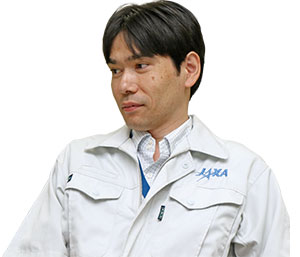
Researcher, Aviation Systems Research Unit
Showing that a silent supersonic transport is possible
Naka: In the US, venture companies like Boom and Aerion have come to the fore and are working to make commercial supersonic aircraft available around the mid-2020s. The International Civil Aviation Organization (ICAO) is also engaging in discussions to formulate international standards on sonic booms and takeoff and landing noise caused by supersonic aircraft. What kind of role do you think JAXA should play under these circumstances?
Ueno: It’s been quite a while since the Concorde was taken out of service. When you also take into consideration the time span normally required for a technology to be implemented after it is established, I think we still have a long way to go before supersonic aircraft becomes available to the public. If we were simply trying to rehash the Concorde, we’d be ready to fly already, but we need to reduce noise and drag. That’s going to take more time.
Akatsuka: I believe it’s important to show that a silent supersonic transport is feasible. My research involves reducing engine noise during takeoff and landing, and predicting and evaluating noise levels around airports. So for me, I think it would be important to show that noise generated by supersonic aircraft around airports can be reduced to acceptable levels in opening up a market.
Ueno: I work on conceptual designs of supersonic aircraft, and I am determined to draw up a workable concept. As a first step, I’d like to present various airframe configurations that can reduce drag and sonic booms.
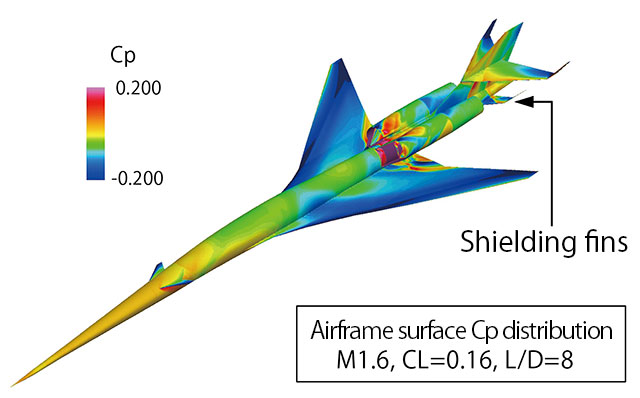
One of JAXA’s concepts for silent supersonic transport. Researchers are aiming to develop airframe configurations that will reduce sonic booms, for example, by shielding strong shock waves (areas indicated in red) generated at the intakes with the main wings to keep them from reaching the ground.
Yuhara: My role in the “R&D for system integration for silent supersonic airplane technologies (S4)” is to design the airframe of the “S4 technology demonstrator (S4TD).” This work has given me more opportunities to interact with people who work for manufacturers both in Japan and abroad. I feel that these interactions have broadened my view. It would be great if I can gain insights that lead to new technologies by sharing ideas with people outside JAXA.
Naka: JAXA started research and development of supersonic aircraft in the late 1990s. We did two projects, NEXST-1 and D-SEND, with the aim of finding ways to achieve improvements in economic efficiency and environmental friendliness required in the next generation of supersonic aircraft. I believe you were involved in the D-SEND project.
Yuhara: Yes. I was responsible for measuring sonic booms in one of the tests conducted in the project. Since I had only one shot at obtaining the data we needed, I remember making a lot of effort to determine the perfect arrangement of microphones and other details. The data we obtained in the D-SEND project is highly regarded overseas as well and used by the ICAO as a reference in formulating its standards. To take the initiative in the global arena, I think it’s important to keep doing demonstration tests like this.
Developing supersonic aircraft technology with broad applications
Naka: In terms of relationships with manufacturers, I’m sure there are challenges as well. After all, we can’t just hand them the technology we developed and expect that they will apply it on their own.
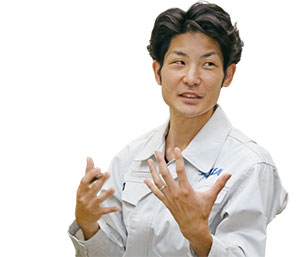
Associate Senior Researcher, Aviation Systems Research Unit
Yuhara: Absolutely. You have to always think about what’s best for the manufacturers. For instance, instead of developing a new technology from scratch, it might be better for them if you could profile an aircraft which was actually in use, like the Concorde or a fighter jet, and modify its airframe to reduce sonic booms.
Naka: How would you like your research to be utilized? What thoughts do you have about your own research?
Yuhara: I’d like to collaborate with more people. Right now, I’m designing a demonstrator with partners at manufacturers, and I want to pass on the technologies we have to them. If possible, I’d like to do more collaborative work with universities as well.
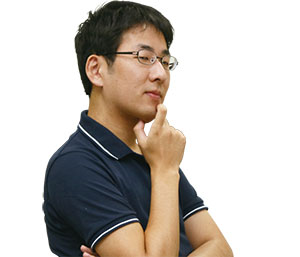
Researcher, Aviation Systems Research Unit
Akatsuka: It would be great if we could develop supersonic technologies applicable to wider purposes. For example, in the automobile industry, technologies developed for F1 racing machines are sometimes applied to production-based machines. As some of the supersonic technologies deal with technical issues common to subsonic passenger aircraft, I think there are ways to make enhanced use of supersonic technologies for subsonic transport and other fields. To enable that, I would like to interact and engage with more diverse talent, including those working for manufacturers and studying at universities.
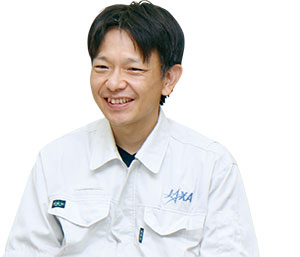
Associate Senior Researcher, Aviation Systems Research Unit
Naka: To open ways to enable future supersonic transport with our technologies, we would like to continue making research and development efforts as well as conducting flight demonstrations.
“Hearing the thoughts of our young researchers pursuing research and development on the front line, I strongly felt that the will of the researchers who worked on JAXA’s earlier projects related to supersonic transport has been handed down to succeeding generations. It is very encouraging to know that the goals of our current research and development are shared by the members”
MAKINO Yoshikazu
Director, Aviation Systems Research Unit